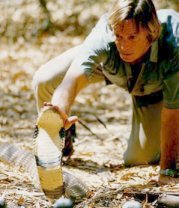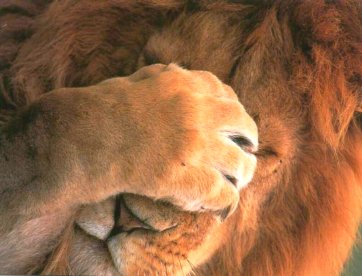Years later, comes this point of view, which would change my perceptions of the Crocodile Hunters of TV forever.

Dancing with death
Anybody remember Austin Stevens? The "snakeman, herpetologist, adventurer, photographer, filmmaker" and "author"? I do. But not Andrew Marshall, apparently. The shift in thought I'd just mentioned was reinforced when watching him again one day.
In an episode of Austin Steven's Most Dangerous, he was looking for a king cobra. At one point he voiced his frustrations at not being able to find one. Then, by the law of the last 15 minutes - huzzah! - they found a wild specimen. Watching him sweatily dance around a snake that just wanted to get the hell out of there was excruciating. Not content to get his photos, he also wanted to pet the snake, something he "wanted to do" for years. And when he does, oh boy, does he sound ever so elated.
If you'd seen it, you'd be rooting for the snake, too.
Even before Steve-O's untimely demise, the nature show machine was already becoming more and more mass-market. It's good television, provided that the core messages were also being sent. Now, I'm no longer sure that's the case.
Well... maybe these wildlife experts are experts. Maybe they do love nature enough to know they shouldn't molest potentially lethal species for television. Maybe there are times when they would advise against all these stunts.
But TV demands an audience, one that's developing an appetite for mindless action and gore nurtured by the entertainment and games industry. And so, even experts have to bend over and violate a few moral tenets for exposure and a living. Kind of like the chefs in those reality and travels shows.
Sending (and receiving) the wrong signals
While the proliferation of celebrity chefs would do relatively little harm, I feel that the nature show industrial complex played a role in the mess caused by the exotic pet industry. A few TV shows and an Internet-enabled device and somebody's an "expert" on Burmese pythons and monitor lizards.
Did they miss the part about Burmese pythons being able to grow up to 7 feet long within a year, if cared for properly? Or that a 10-footer can easily kill a child? Or the massive sizes they can achieve if kept alive for years?
Exotic pet industry advocates say the trade creates jobs, fosters understanding about wildlife and the environment, and so on. Well, the firearms industry creates jobs too. But people can't be counted on to be responsible with their pets or guns all the time.
These exotic pet traders expect their customers to be knowledgeable and responsible pet keepers. The Burmese and African rock python invasion of Florida's Everglades is the result, possibly due to the negligence of a few irresponsible individuals. The snakehead "invasion" in Maryland was reportedly caused by one fellow.
And how does taking a Burmese python out of Burma help in understanding nature and the environment? Or help in conservation, even? Why should little Timmy have a bearded dragon, just because it's cool to have one and "Mark down in Shepford Avenue has one too and oh, his dad keeps a Gaboon viper"?
The so-called wild creatures can't demonstrate their roles in their natural habitat when they're not in their natural habitat. Nor can they speak for themselves, which is why we need real animal experts. I don't think the commercial exotic pet trade helps with this at all.
Those traded animals that didn't come from a factory farm were likely caught illegally from habitats that may not afford the loss of these species. The National Geographic article on the Asian wildlife trade still fills me with shame and fury, as does the extermination of the animals in Muskingum, Ohio.
And how can these wild creatures be compared to other domesticated animals such as dogs and cats? A pet shop is not a Toys-R-Us. Kids will get bored with their toys, just as they will with pets. And there are no recycle bins for unwanted African rock pythons or Indian star turtles.
Coming home to roost - or nest
We often fail to understand that many of this planet's creatures evolved to perform certain duties necessary to keep the circle of life going. The effects of any unnatural tampering of this circle may not be known for years and by the time they're felt, it's often to late.
With regards to pythons in the Everglades, nobody knows exactly how these snakes react when placed in a foreign habitat. Will they be eventually killed by the climate, or will they evolve to fill the niche they're placed in?
Wildlife experts now fear the possibility of the latter, a worst-case scenario where these pythons would spread beyond Florida or, worse, breed a hybrid Burmese-African super python.
Sceptics argue that snakes won't survive the winters outside Florida and, hell, we ain't seen a super snake yet. That's because the twain hath never met - Burma, Africa, you know. But now that both species are sharing the same neighbourhood, it may only be a matter of time.
Keep it real
Not to denigrate the good work these wildlife warriors do off-camera, but I don't really feel the action-adventure circuit does much good for wildlife conservation or the reputation of the related professions in the long run.
Not when the nature channels appear to be pandering more and more to the action-adventure- and blood-and-guts-loving demographic, distilling their subjects down to tiny yummy, bloody bites for an increasingly attention-deficient dumbed-down audience.
I'm not sure they dance with crocs or wrestle great white sharks onto boats for tagging, measuring and DNA sampling for the glam. It's hard work, more a labour of love or a duty to inform. Cliché, perhaps, but that's what I'd like to believe.
(I've not heard of researchers who treat field work as a "job", but I'm sure they exist).
Just as these shows reduce these dedicated men and women to Crocodile Hunters, Snake Busters or Shark Men, these wild animals and their roles in their exclusive ecological niches are similarly reduced to just stripes, spots, fins, scales and sharp teeth, to be gawked at, feared or admired, and perhaps owned. Trophies, trinkets, ornaments. Status symbols.
These people and the wildlife they work with are more than that. And it's time we all learn how much.
I wrote this back in 2012, partly in response to an article that commemorated Steve Irwin, a few years after his death. Things are hectic at the company, which is why there are more pictures than prose around here these days, and only when I can be bothered - not even enough time to compile the space-filling listicles I used to be fond of.
Categories:
NatGeo Moments

0 comments:
Post a Comment
Got something to say? Great!